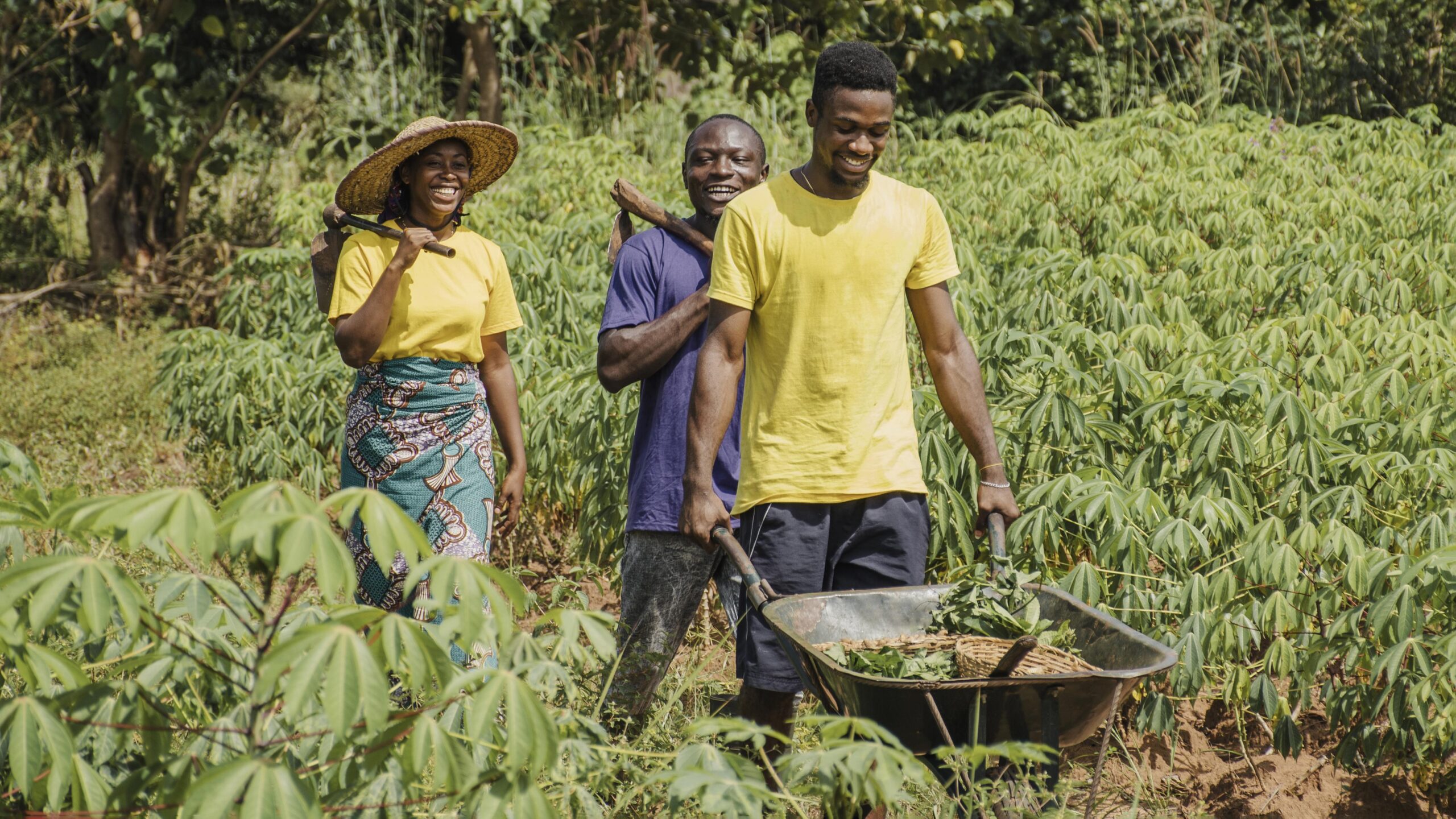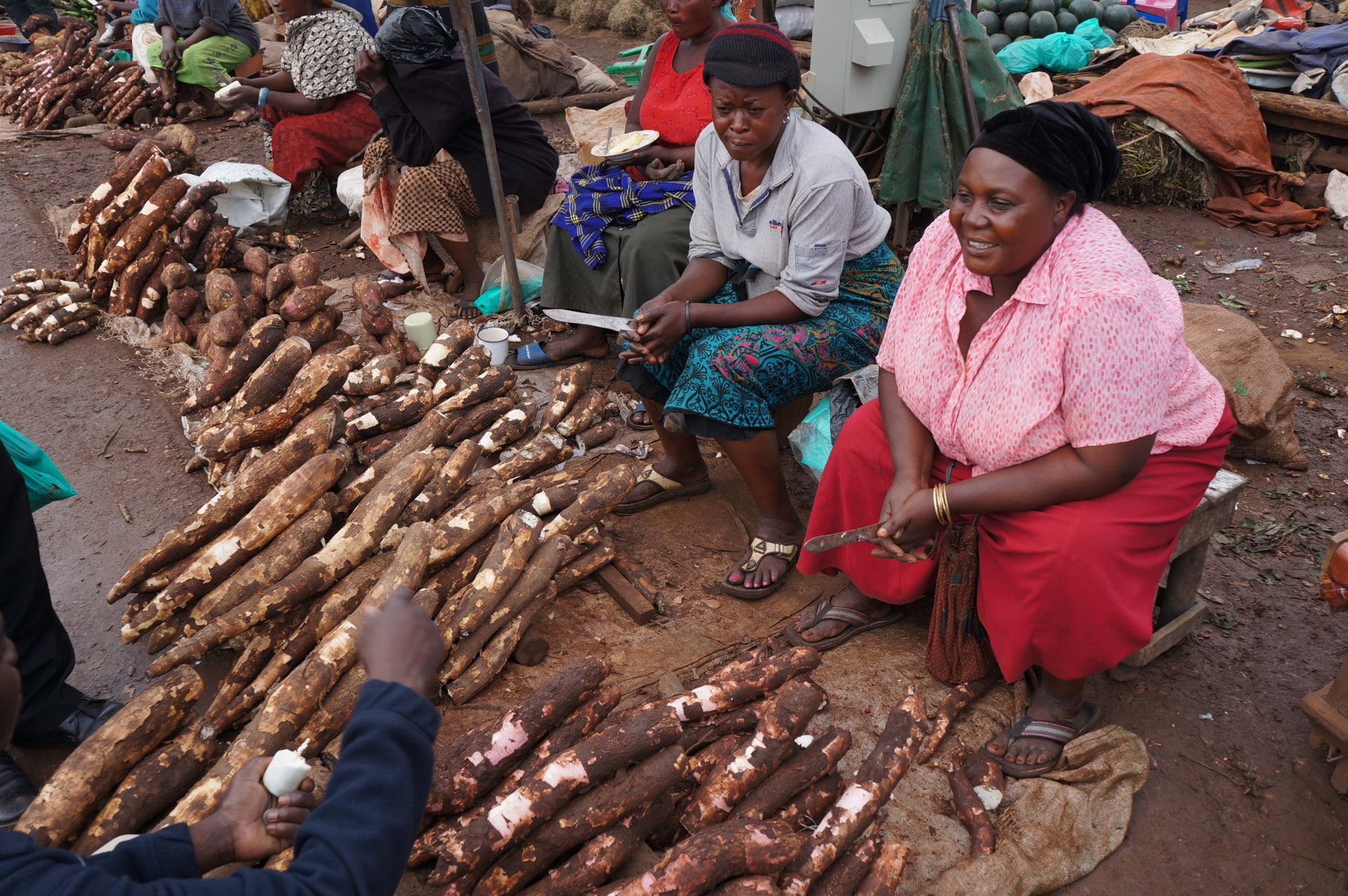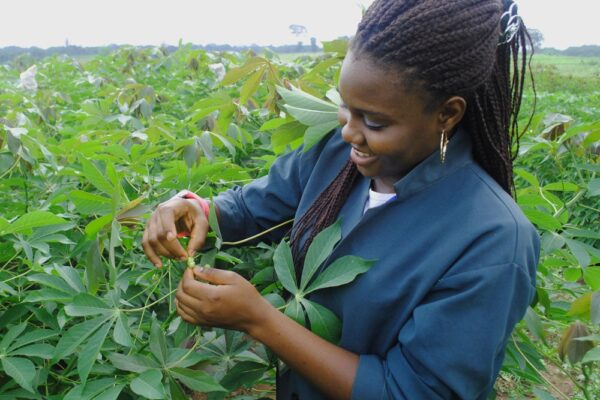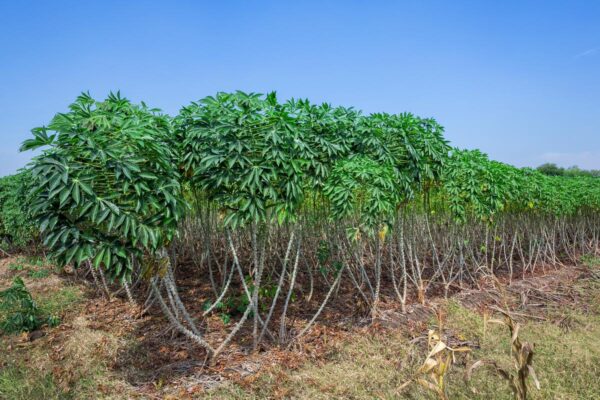On May 19, 2022, farmers, processors, and government officials from the Kogi region of Nigeria gathered for a farmers’ field day. They were there to harvest the crop that had been planted eleven months earlier: a new cassava variety named Game Changer. As they shook the dirt off, they marveled at the plant’s numerous, large roots. Game Changer, they observed, yielded more than their favorite variety, TMEB419.1 Indeed, since the two varieties had been planted side by side, they could easily see that the differences were dramatic. The plant breeders who developed the variety pointed out that Game Changer could produce 32 tons per hectare under farmers’ field trial conditions, a dramatic increase over the national average yield of 8 tons per hectare.2 Beyond that, the variety was stress-tolerant, disease-resistant and had high dry matter and starch content—important food quality properties.3 After the roots were harvested, the farmers watched as the field day organizers used them to prepare gari, eba and fufu, encouraging them to sample the foods to experience Game Changer’s high food quality.4 Impressed, the farmers were eager to try their hand at growing the new variety. “All of us, we like it. And everybody agrees . . . to test it,” said cassava farmer Muhammed Memunat. “Because we see the root of . . . Game Change[r] is . . . better than [TMEB]419,” she said.5
CHANGING THE GAME WITH GENDER-RESPONSIVE BREEDING
Cassava in Nigeria
Cassava, a woody shrub harvested for its starchy roots as well as its leaves, is a staple food crop in Nigeria. Compared to other food crops, cassava requires significant postharvest handling and processing. The roots have to be carefully stored because they are highly perishable, and care must be taken to reduce its cyanide content through grating, fermenting, and sun-drying—which also makes it more palatable.6 Cassava can be consumed fresh after boiling the roots or can be made into storable dry food products.7 The most popular foods made from cassava are gari, fufu and eba.8
More than four million farmers in Nigeria grow cassava, producing food for over 100 million people.9 Indeed, Nigeria is the world’s largest cassava producer. The tuber is grown both as a subsistence crop and as a cash and industrial crop across sub-Saharan Africa.10
Nigeria’s government considers cassava a key strategic crop—particularly since it is less vulnerable than cereal and legume crops to the impacts of climate change and can withstand harsh environmental and agronomic conditions.11 As a result, the government crafted policy and legal frameworks to encourage and support its adoption by farmers.12 Cassava is also a key import substitution crop, helping Nigeria make progress toward its goal of self-sufficient food production.13
Cassava Trait Preferences
In 2013, the NextGen Cassava Breeding project was launched to support research that would shorten the cassava breeding cycle, decreasing the time needed to develop a new variety. “Close to a billion people depend on cassava for their daily food, especially in the developing world,” said Chiedozie Ngozi Egesi, senior scientist at the International Institute of Tropical Agriculture (IITA) and project director for NextGen Cassava. “So anything we do in terms of improving the productivity of the crop, improving the value chains around the crop, has a direct relationship with improving food security, enhancing income capabilities of growers, and creating jobs along the value chain.”
Prior to the establishment of NextGen, Nigerian cassava breeding programs had prioritized “one size fits all” traits in setting breeding agendas, designed to impact the largest possible number of people through improved varieties.14 Yield and pest resistance, for instance, had been chiefly emphasized, a common denominator approach that had been successful, with the proportion of improved varieties planted by farmers increasing between 1998 and 2009.15 Even so, adoption of modern varieties lagged behind hoped-for growth.16
Some researchers believed that cassava breeding programs were failing to take into account other traits desired by farmers and processors.17 Indeed, one study found that high yield alone would not spur adoption, unless the variety possessed other specific traits that farmers considered important. “The key here is to balance quality, survival, and output traits. While agronomic constraints are important, socioeconomic and demographic variability are critical factors in adoption,” wrote the study’s authors.18 Low adoption of modern varieties among women farmers in particular was commonplace, due to differences in trait preferences (among other factors). One researcher noted: “Gender inequality was a stumbling block to varietal adoption when women and men had different trait preferences, because they faced unequal costs and benefits from adoption and use.”19 As important as understanding how men and women valued traits differently was understanding why. One interview-based study noted that while breeders often just wanted to be told trait rankings, it was important to understand how women’s roles in cassava farming and production determined how they prioritized traits.20
Understanding Gender Difference in Trait Preference

By 2015, NextGen, whose 20 partner organizations included the two primary cassava breeding entities in Nigeria — IITA and National Root Crops Research Institute (NRCRI) — had begun to shift to gender-responsive breeding, establishing a research team to better understand the needs of diverse growers, processors and consumers, especially women. The team reviewed the Cassava Monitoring Study (CMS), a large study done by IITA in 2015, which had collected sex-disaggregated data from 2,500 households and documented information on men and women’s preferred and non-preferred characteristics at each step of cassava processing.21
The next year, the project hired a gender research specialist to analyze the CMS data as well as a large volume of sex-disaggregated data already collected by several projects (including data collected by the RTB foods project to assess trait preferences related to cassava food quality characteristics) in order to interpret how these data would change breeding objectives and trait prioritization.22 The resulting gender analysis found significant gender differences in variety and trait preferences for cassava in Nigeria. Traits such as “easy to peel” and those related to “food product quality” like cooking time, taste and root color were mentioned more frequently by women than by men, reflecting women’s strong participation in cassava processing and trading.23 The findings were hardly surprising. Cassava played a dominant role in the livelihoods of rural, small-holder farmers in Nigeria, with women taking a central role in both the management and labor of production, processing and marketing. Indeed, women provided up to 70% of the labor involved in Nigerian cassava production, and the processing, too, was mainly done by women.24 As a result, women were seen as more knowledgeable and experienced in cassava production. One researcher noted that women even bore a nickname. “Women are called ‘cassava queens’ . . . in terms of how women take decisions in terms of cassava processing and marketing, it’s pretty single-handed. They own the businesses,” said one interviewee during a research survey.25 While women’s involvement in production-related decisions was limited by their control or ownership of land, which was patrilineal, they provided labor for weeding, sales and processing activities for both consumption and sale, for instance.26 Given their overlapping roles in production, men and women often preferred the same traits. As an example, men and women showed no difference in preference for dry matter content and fresh root yield.27 For other traits, the differences were significant. While men expressed a preference for high yielding varieties and large root size, women largely focused on taste, dry matter content and early maturity.28 While earlier maturing varieties were preferred among both men and women as a source of quick income, women linked the benefit of early maturity to food security for the household. “Varieties have been abandoned because they don’t mature fast, taking about three years to mature before harvest. We cannot wait for that long before we feed our children,” said one woman farmer to a researcher.29
Women ascribed greater importance to cooking and processing traits—such as sweetness, color and taste—than men, findings that validated the assumptions that gendered divisions of labor in cassava production and processing directly influenced trait preferences.30 Women wanted varieties that would reduce the labor required for weeding: varieties with plentiful branching leaves and fast maturation reduced weeding time, for instance.31
Gender-Responsive Breeding
When Peter Kulakow, a cassava breeder and geneticist with IITA, first heard of the idea of gender-responsive breeding—using gender-related information to guide breeding decisions—he was enthusiastically supportive. “It’s an excellent idea thinking that all people should be treated equitably,” he said.
Kulakow, who had first heard the idea in 2009 when he arrived in Africa to start working on cassava breeding, realized its value immediately. “We would have field days to show farmers the results from our research, and the people who would show up to those field days were predominantly men. Women were not included,” Kulakow said. “There wasn’t sufficient participation of women in what we were doing,” he said.
Egesi, however, was initially skeptical: he thought it sounded like low-budget feminism. “That was the mindset,” he said. Though he found it difficult to embrace the idea initially, “eventually, we got to understand there was a good case made for how gender responsiveness would enable adoption,” Egesi said.
Béla Teeken, a gender scientist with IITA, was well-acquainted with breeders’ skepticism. “Initially, they focused on higher dry matter and higher yields and disease resistance. They didn’t really think about the possible differences in processability of the varieties. They did not consider the cultural value of a good food product, the quality of the different food products.” (Bela Teeken was interviewed by the case writer on June 13, 2023). Teeken noted that this was due in part to public breeding funding mechanisms which were not demand-driven. “Breeders did not have to account for the adoption rate of the products that they delivered.”
Teeken said that what started to lower breeders’ skepticism was participatory processing. “They all knew about PVS (farmer participatory variety selection)—we plant some varieties in farmers’ fields and they provide feedback to the breeders about the varieties. But now what extended this exercise including processing: we processed those different varieties within the communities with different people, and then we let them assess which one is better and why,” Teeken said. The breeders saw for themselves that the processors—often women—were concerned with the texture of the food or the discoloration during processing, and they put an emphasis on food product quality. “That convinced the breeders,” Teeken said. “With food scientists we worked to translate such findings into bio-physical traits that can be measured and that breeders can use to select. Visiting in the field and then showing breeders the effects are real—instead of just saying, in abstract terms, that quality is important—convinced them.”
Changing Donor Priorities
By the early 2010s, decades of gender research and advocacy had shifted donor priorities. Major donors began to make gender-responsiveness a condition of funding, spurring CGIAR, the global agricultural research organization, to introduce formal requirements for its programs to integrate gender into annual work and budget plans in 2013—the first time a formal, financial obligation to do so was instituted.32 “So it was easy to adopt this idea that our research program needed to be gender responsive,” Kulakow said.
However, in the two years following the introduction of the requirement, plant breeders and the gender researchers hired by programs experienced difficulties in finding ways to work together that demonstrably enhanced gender-responsiveness. This same experience was occurring elsewhere in the CGIAR, prompting the formation of the Gender and Breeding Initiative (GBI) in 2016 with the objective of developing common ground between breeders and gender researchers. The GBI aimed to foster “the co-design of practical approaches and tools” that would make it easier for breeders to identify desirable or undesirable features of varieties at different stages in the breeding pipeline.33
The next year, in 2017, NextGen Cassava launched its own program, the Gender-Responsive Cassava Breeding Initiative, to “give voice to the voiceless,” Egesi said. To conduct “smarter” cassava breeding, Egesi said, breeders needed to be gender responsive. “We were sold on disease resistance, production characteristics or high yielding varieties,” he said. But though such varieties had been released over the years, high adoptions did not follow. Egesi explained: “The men farmers are still talking about production and disease resilience parameters. And if you talk to the women in the presence of their husbands or the men in the community, they will echo the same thing. But when you separate them in a women-only focus discussion, you will hear them say, ‘The real problem with that variety is that it does not rise; it does not swell when you prepare the food product from it.’ So it’s no longer something in the field. It’s now something in the kitchen. But that thing in the kitchen started from the field. The breeder did not select a variety with a high swelling capacity. So the question is, how does the breeder breed for that?”
Egesi said it became obvious that breeders were overlooking something important. “We began to understand that breeding is not for breeders alone, but for social scientists, food scientists, farmers, and processors also,” he said. Kulakow said that some of his peers erroneously believed they were already engaging in gender-responsive practices—confusing it with being customer-focused. “But that is not the same thing. There was just this notion that how could our work not be inclusive?” Kulakow said.
Kulakow said his program was designed explicitly to ensure that the gender lens was included in the decision-making process. “We have a scalable product management decision-making process, where we decide who makes decisions at different stages in our plant breeding program. I’m not sure that you have to consider gender at every single stage, but there are critical stages where we need to be sure that the gender lens is present at the table. So we’re formalizing who has rights over decisions and making sure that the people who represent the gender perspective are at the table,” he said.
Kulakow said the first critical point where gender would be an important consideration was at the very start of the process. “Deciding what you’re going to do in the first place: When you set your priorities, you need to have a full cross-functional team at the table to set those priorities. And it’s not just based on a single expert’s assessment of the situation, but you really need to know what different consumers prefer,” Kulakow said. “You need to know the economic impact or the social impact of including this trait into your variety.”
In his program, he assembled a team led by social scientists that collected gender-related information on trait preferences or the best way to test a variety, for instance. “This is how you get the opinions of the people who matter in the decision-making process,” Kulakow said. “Once you collect that information, you need to be sure that that’s presented when you’re making decisions. If you have salespeople ultimately making your decisions, those salespeople don’t have the gender perspective because it’s all about sales and how much money you’ll make from selling a particular variety. We just need to be sure that the gender information is present, is not lost,” he said.
Kulakow said breeders’ tendency was to focus on agronomic traits like yield because they were easier to measure. But by collecting more information on quality traits, it gave those traits “standing” in the decision-making process. “It adds power to the decision-making process because it’s not just ‘people are saying’—it’s real data and information,” Kulakow said.
After prioritizing traits came the mechanics of the breeding process. He acknowledged that it wasn’t practical to include a gender specialist in every decision, and that doing so might not be as important at some of the intermediate steps. But when testing varieties, either with farmers or in his own trials, Kulakow said it was important to bring back the gender lens: “To make sure that the perspectives of all of your different clients are represented.” And then again when the final advancement decisions are made: “Where you decide what varieties you’re going to try to take to the market,” Kulakow said. “It’s the beginning stages and the later stages where it’s absolutely critical.”
Kulakow pointed out that gender wasn’t really about men versus women, but about the roles they played in farming, harvesting and food production. The roles themselves were mostly gendered. “That’s why we emphasize that gender is not about women; it’s about the roles people play,” Kulakow said.
Game Changer
By 2018, unprecedented investment in cassava research, coupled with greater donor interest in gender responsive agricultural research, had raised the profile of cassava in Nigeria.34 That year, NextGen Cassava, under Egesi’s leadership, began to conduct field evaluations of five new varieties that had been developed by NextGen in collaboration with teams of scientists from IITA and NRCRI.35 Egesi and Kulakow both served as breeders for the new varieties.
The teams were purposely comprised of both men and women. “Because when you do work in communities, you want women speaking with women and men speaking with men,” Kulakow said. The teams also included gender researchers. “Their role was to work with the breeder, to be the lead scientist to take it to the farmer,” Egesi said. “That’s where we have the interaction with the growers. We needed social scientists to be asking questions that crop scientists don’t normally ask.”
He said they also served to compile data and conduct field interviews and report back to the breeders. They learned that some traits—such as high yield and resilience to disease—were crucial traits for any cassava variety. “Those are traits that whatever you do, you should still keep them,” Egesi said. He noted that men said they would be satisfied if a variety met these two traits. “The man thinks that’s all he needs, because he doesn’t go to the kitchen,” Egesi said. “That is all that is important to him, so that is how he makes his decision. The rest is not his business.”
But Egesi noted that agronomic yield was only one definition of yield: women were concerned with product yield. “When they buy roots, how much product can they make from it? A woman may want the product to rise: she still needs a high yielding variety that will give her more money per unit area of cultivation,” he said. Egesi explained that if breeders create a variety that provides a good product yield but not a good agronomic yield, it is not considered a success. “Everybody’s losing. The breeder needs to have that clear mind in understanding that this is what is important. That you can’t have it all, but you need be on the upward curve for both yields. The rate of upward movement is what needs to be tweaked, and that’s the art of breeding,” Egesi said. “Are they sometimes competing biologically? Yes. Some of those traits do. So what compromises would I lose to get the other? That’s a decision the breeder makes based on the market, based on the demand,” Egesi said.
The Trials
Kulakow, a breeder on the IITA team, said that after working to understand trait preferences, they conducted mother/baby trials. “A mother trial is where you’re testing potential varieties, maybe 30 different varieties. But you can’t give 30 varieties to one farmer and ask them to look at it, it’s too many. So the farmers hosted baby trials. You can usually give a farmer three or four and they can tell you which they prefer,” Kulakow explained.
By comparing the baby trials with the mother trial, the team could begin to draw conclusions about which varieties were best received. “The gender research teams are part of conducting these testing trials. So we are testing it with people and getting feedback on what they want,” Kulakow said. Next, they conducted on-station trials, which were more focused on quantitatively measuring traits such as yield.
Egesi said some of the women farmers growing the TMS13F1160P0004 variety did a three-phased evaluation: pre-harvest, harvest and post-harvest selections. “When they saw TMS13F1160P0004 at the time of pre-harvest, they said, ‘this is the worst of the varieties, I wouldn’t go for it’,” Egesi said, who noted the variety was somewhat unattractive, which initially put off some farmers. “When they look at the shoot system, it doesn’t look so comely, it doesn’t look healthy on top.”
But the women changed their minds after they harvested the variety and saw the roots. “Everybody marveled and they made notes for the breeders. One of them wrote an apology that they were very sorry they had underrated it, but that it has proven to be far better in terms of yield than the others, including TMEB419,” Egesi said. Later, after the farmers had converted the cassava to gari and fufu, they found the food yields to be very high. “Everybody wanted it and the seed became scarce. There was a scramble,” Egesi said. Not only did the variety beat TMEB419 in terms of yield in the field, it also became the preferred variety for consumption. “When they also tested the feeling in the mouth, it was like, ‘Whoa, this is what we really wanted.’ It became an instant hit,” Egesi said.
Selecting the Winner
Egesi called a meeting with the farmers, processors and marketers and invited them to a naming ceremony for their new variety. “When it came to each variety, they would bring it out, suggest two or three names, then vote. When it came to TMS13F1160P0004, they said they don’t even know what name to give this variety because it has changed the way they perceive varieties. It had also become the variety that would ultimately replace the most popular one [TMEB419]. So one of them says, ‘So why don’t we call it Game Changer?’” Egesi said. The vote was unanimous, and the name adopted.
Results from the on-farm evaluations showed that Game Changer outperformed the national check. Indeed, based on farmers’ rankings and “overall acceptability,” Game Changer was consistently ranked highest relative to the best local variety. Game Changer recorded higher dry matter content values in comparison to the local best variety and the commercial check variety, TMEB419.36
Teeken noted that during a triadic comparison of technology (tricot) trial analysis, they discovered that the Game Changer variety was particularly liked by women PVS participants. “If you really stepped into the women’s needs in the role of processing and also in the role of farming, we saw that that variety was especially well performing,” he said.
In addition, Game Changer was preferred over the national and local checks for both gari and fufu products. “This gives an indication of the potential acceptability and adoption of [Game Changer] as [a] substitute or replacement for high gari and fufu cassava varieties,” Egesi wrote in his registration application. He noted the distinctive characteristics of the Game Changer variety included (in addition to very high dry matter and high yield) brown stem, profuse branching, broadly adapted, very suitable for gari and fufu, very suitable for high quality flour and 100% sprouting ability.37 The single-cross hybrid also matured quickly (10-12 months), and was resistant to cassava mosaic disease and several other pests and diseases.
After defending the variety before a meeting of Variety Release Committee of Nigeria, Egesi said Game Changer was officially registered and released in December 2020.
For the first time, NextGen acknowledged formally making use of the findings and recommendations of gender research in its team decision to advance five candidate varieties for release—including Game Changer—as a multi-purpose cassava variety for Nigerian growers.38 Reflecting back, Kulakow said all five new cassava varieties NextGen launched in Nigeria at the end of 2020 had benefitted from a gender-responsive approach. “A lot of information came from working in communities and deciding what quality attributes in terms of color, texture, and taste people wanted. We may not have released the same varieties if we didn’t have that information. These varieties are promising, because they fit the market well and also addressed some of the gender-responsive information collected,” he said.
Game Changer was particularly gender responsive because of two important attributes. First, it was important to women for cassava varieties to have as little water as possible in the roots. “Or, it ends up being starch in place of cassava. [Game Changer] has a high and fairly stable dry matter content,” Teeken said.
The second attribute was color. “The breeders knew that people liked white flesh color, but they thought that the white color of the root was directly reflected in the food product color. And to a certain extent that is true, but there’s also enzymatic browning or post-harvest physiological deterioration that can happen,” Teeken said. “The initial root flesh color can be very white but when you do more fermentation you see that the color of the flesh changes and then even the intermediate products change color. And then farmers or processors will quickly let that variety go because that’s something they cannot handle. Because the product doesn’t look appealing, it doesn’t look bright—it’s brownish or grayish, and that’s absolutely not tolerated. The Game Changer variety did not change color—it stayed bright white during processing—and that’s why it was so highly valued.”
Kulakow agreed and noted that a plant breeder who wasn’t paying attention to the surveys might produce a variety with high yield but that when processed, the end product—while plentiful—was unappealing. In Game Changer, however, the cassava retained its color and could be processed into food with good texture, making it an appealing product.
Egesi was hopeful that Game Changer would unseat the current favorite. “The most popular variety in Nigeria was TMEB419. If you try to give a farmer a variety, they will ask you, ‘is it TMEB419?’ And if you say no, they lose interest. So to replace that variety, you really need to up your game. That was our challenge.”
Everyone Wins

Egesi believed that everyone in the supply chain benefitted when breeders took gender-related preferences into account. “If I’m a male farmer, I stand the chance of getting more from my farm, even as a man, because the breeding work is more gender-responsive, because we now have better varieties,” he said. He also believed that empowering women by giving them more voice during the breeding process helped the men to see and understand the value of women’s participation. “Because when women speak out, everyone in this ecosystem benefits,” Egesi said.
Teeken noted: “Men who do not process often sell their roots to processors, so if the roots are better for processing and food product quality, the seller will get a higher price for the roots, so everyone in the value chain benefits. This shows that trait preferences as expressed by men and women are often complementary rather than contradictory.” Kulakow agreed. “Because you’re creating a stronger market for your products, it benefits whoever benefits from those products. So if the benefits stream towards men, you can use gender-useful information from, say, female farmers or female processors. And then you get a product that meets the market demands better. That’s why it’s not just about gender-responsive breeding, but it’s also gender-responsive marketing, outreach and information sharing. It has to spread across the whole value chain,” Kulakow said.
Kulakow felt that building gender responsiveness into breeding programs modernized the operations, made them more efficient and held out the potential for a better return on investment for donors—in addition to offering positive social impacts. “We should be using the best available tools. These should be part of what we use in our toolbox routinely,” Kulakow said.
Teeken believed that for public breeding, gender responsiveness was a very important factor to improve agriculture in the Global South. “You see a large gender division of labor and also in opportunities between men and women, especially in Africa, where they have different opportunities and different working conditions. So, it is very important to look at the specific needs of men and women with regards to how they can generate income or cultural satisfaction,” he said, noting that without this consideration, breeders were not creating adoption among the people that public breeding targets. “Public breeding is targeting to improve smallholder conditions and to create larger opportunities for generating income and even food sovereignty among communities. And if breeders don’t acknowledge the different needs that are created because of the labor division and the different position and possibilities men and women have as a result of gender norms in communities, public breeding may as well close down and let all the commercial breeders take over. But then the needs of many poor, food insecure or otherwise underprivileged people will not be addressed by these private endeavors.”
Breeders themselves benefitted from taking gender into account. “If your variety is adopted and successful in the market and/or has higher social impact, like it reduces poverty or it improves nutrition or reduces food insecurity, then as a breeder you’re a winner because people recognize that you’ve released a successful variety and it’s become successful in the market or in the social impacts you’re trying to achieve,” Kulakow said. “So the breeder in some ways can’t lose by including this information. Otherwise, you’re just relying on luck. But here you are making more informed decisions.”
Study Questions / Discussion Prompts
- Kulakow and Egesi had different perspectives on the value of gender responsive breeding. What were these? Who do you agree with and why?
- Increasingly, breeders find that donors are pushing for more demand-driven variety development. This means breeders must make important tradeoffs regarding whether to identify trait priorities of particular, potentially marginalized groups or prioritize larger impact through yield gains. Kulakow said that some of his peers erroneously believed they were already engaging in gender-responsive practices—confusing it with being customer focused. Describe how being customer focused may be different from being gender responsive.
- One school of thought holds that since breeding involves prioritizing traits that are valued differently by different social groups, the decision to select one trait over another is, by definition, a decision to privilege one group and their preferences over another. But Kulakow didn’t see it that way. “It’s more about being inclusive and privileging more people rather than some people over another. It’s not like one group wants one thing as opposed to the other. It’s more nuanced. Men and women generally prefer similar things, but they’d have different emphasis in what they would prefer,” said Kulakow. Which statement do you support and why?
- One criticism breeders sometimes make is that including gender-responsive data creates too many preferences to breed for. The challenge, then, is for breeders to be able to create combinations of characteristics in varieties that meet different needs. For Game Changer, how did this play out? Were the breeders able to balance the preferences demanded by different groups?
- Breeding is a long and expensive process, and collecting information from a broad range of growers, processors and consumers is complicated. How did breeders get the information they used to make gender responsive breeding decisions? What methods or tools were used?
- There is mention of women’s roles and their preferences several times in the case. For example breeders mention “the kitchen” being important for women, or research talking about men caring about income while women focus on feeding their children. How do you think these statements could be harmful for women cassava farmers?
End Notes
1 “New improved cassava varieties excite farmers,” News section, Cassava Matters website, May 26, 2022, https://cassavamatters.org/new-improved-cassava-varieties-farmers/, accessed November 2, 2022.
2 “New improved cassava varieties excite farmers,” News section, Cassava Matters website, May 26, 2022, https://cassavamatters.org/new-improved-cassava-varieties-farmers/, accessed November 2, 2022.
3 “New improved cassava varieties excite farmers,” News section, Cassava Matters website, May 26, 2022, https://cassavamatters.org/new-improved-cassava-varieties-farmers/, accessed November 2, 2022.
4 “New improved cassava varieties excite farmers,” News section, Cassava Matters website, May 26, 2022, https://cassavamatters.org/new-improved-cassava-varieties-farmers/, accessed November 2, 2022.
5 https://www.youtube.com/watch?v=OqKZTsZJQ5c, accessed November 2, 2022.
6 Hanna Ewell, “Breeding for impact: perspectives on gender-responsive cassava breeding in Nigeria,” Gender, Technology and Development, Volume 25, No. 2, pp. 217-232, June 30, 2021, https://doi.org/10.1080/09718524.2021.1939962, accessed October 12, 2022.
7 Balogun, I., Garner, E., Amer, P., et al, “From traits to typologies: Piloting new approaches to profiling trait preferences along the cassava value chain in Nigeria,” Crop Science, Volume 62, Issue 1, January/February 2022, pp. 259–274. https://doi.org/10.1002/csc2.20680, accessed August 9, 2022.
8 Teeken, B., Garner, E., et. al., “Beyond ‘Women’s Traits’: Exploring How Gender, Social Difference, and Household Characteristics Influence Trait Preferences,” Frontiers in Sustainable Food Systems, December 14, 2021, https://www.frontiersin.org/articles/10.3389/fsufs.2021.740926/full, accessed August 9, 2022.
9 Bela Teeken, Olamide Olaosebikan et. al., “Cassava Trait Preferences of Men and Women Farmers in Nigeria: Implications for Breeding,” Economic Botany, July 12, 2018, volume 72, pp. 263-277.
10 Teeken, B., Garner, E., et. al., “Beyond ‘Women’s Traits’: Exploring How Gender, Social Difference, and Household Characteristics Influence Trait Preferences,” Frontiers in Sustainable Food Systems, December 14, 2021, https://www.frontiersin.org/articles/10.3389/fsufs.2021.740926/full, accessed August 9, 2022.
11 Bela Teeken, Olamide Olaosebikan et. al., “Cassava Trait Preferences of Men and Women Farmers in Nigeria: Implications for Breeding,” Economic Botany, July 12, 2018, volume 72, pp. 263-277.
12 Chiedozie N. Egesi, et. al., “Nomination for registration and release of four multi-purpose cassava varieties for food security (Hope and Baba-70) and industry (Game Changer and Obasanjo-2) product profiles in Nigeria,” National Root Crops Research Institute and International Institute for Tropical Agriculture, 2020.
13 Chiedozie N. Egesi, et. al., “Nomination for registration and release of four multi-purpose cassava varieties for food security (Hope and Baba-70) and industry (Game Changer and Obasanjo-2) product profiles in Nigeria,” National Root Crops Research Institute and International Institute for Tropical Agriculture, 2020.
14 Bela Teeken, Olamide Olaosebikan et. al., “Cassava Trait Preferences of Men and Women Farmers in Nigeria: Implications for Breeding,” Economic Botany, July 12, 2018, volume 72, pp. 263-277.
15 Bela Teeken, Olamide Olaosebikan et. al., “Cassava Trait Preferences of Men and Women Farmers in Nigeria: Implications for Breeding,” Economic Botany, July 12, 2018, volume 72, pp. 263-277.
16 Hanna Ewell, “Breeding for impact: perspectives on gender-responsive cassava breeding in Nigeria,” Gender, Technology and Development, Volume 25, No. 2, pp. 217-232, June 30, 2021, https://doi.org/10.1080/09718524.2021.1939962, accessed October 12, 2022.
17 Bela Teeken, Olamide Olaosebikan et. al., “Cassava Trait Preferences of Men and Women Farmers in Nigeria: Implications for Breeding,” Economic Botany, July 12, 2018, volume 72, pp. 263-277.
18 Balogun, I., Garner, E., Amer, P., et al, “From traits to typologies: Piloting new approaches to profiling trait preferences along the cassava value chain in Nigeria,” Crop Science, Volume 62, Issue 1, January/February 2022, pp. 259–274, https://doi.org/10.1002/csc2.20680, accessed August 9, 2022.
19 Polar, V. et al. (2022). Building Demand-Led and Gender-Responsive Breeding Programs. In: Thiele, G., Friedmann, M., Campos, H., Polar, V., Bentley, J.W. (eds) Root, Tuber and Banana Food System Innovations. Springer, Cham. https://doi.org/10.1007/978-3-030-92022-7_16, accessed August 10, 2022.
20 Hanna Ewell, “Breeding for impact: perspectives on gender-responsive cassava breeding in Nigeria,” Gender, Technology and Development, Volume 25, No. 2, pp. 217-232, June 30, 2021, https://doi.org/10.1080/09718524.2021.1939962, accessed October 12, 2022.
21 Polar, V. et al. (2022). Building Demand-Led and Gender-Responsive Breeding Programs. In: Thiele, G., Friedmann, M., Campos, H., Polar, V., Bentley, J.W. (eds) Root, Tuber and Banana Food System Innovations. Springer, Cham. https://doi.org/10.1007/978-3-030-92022-7_16, accessed August 10, 2022.
22 Polar, V. et al. (2022). Building Demand-Led and Gender-Responsive Breeding Programs. In: Thiele, G., Friedmann, M., Campos, H., Polar, V., Bentley, J.W. (eds) Root, Tuber and Banana Food System Innovations. Springer, Cham. https://doi.org/10.1007/978-3-030-92022-7_16, accessed August 10, 2022.
23 Polar, V. et al. (2022). Building Demand-Led and Gender-Responsive Breeding Programs. In: Thiele, G., Friedmann, M., Campos, H., Polar, V., Bentley, J.W. (eds) Root, Tuber and Banana Food System Innovations. Springer, Cham. https://doi.org/10.1007/978-3-030-92022-7_16, accessed August 10, 2022; and Hanna Ewell, “Breeding for impact: perspectives on gender-responsive cassava breeding in Nigeria,” Gender, Technology and Development, Volume 25, No. 2, pp. 217-232, June 30, 2021, https://doi.org/10.1080/09718524.2021.1939962, accessed October 12, 2022.
24 Hanna Ewell, “Breeding for impact: perspectives on gender-responsive cassava breeding in Nigeria,” Gender, Technology and Development, Volume 25, No. 2, pp. 217-232, June 30, 2021, https://doi.org/10.1080/09718524.2021.1939962, accessed October 12, 2022.
25 Hanna Ewell, “Breeding for impact: perspectives on gender-responsive cassava breeding in Nigeria,” Gender, Technology and Development, Volume 25, No. 2, pp. 217-232, June 30, 2021, https://doi.org/10.1080/09718524.2021.1939962, accessed October 12, 2022.
26 Hanna Ewell, “Breeding for impact: perspectives on gender-responsive cassava breeding in Nigeria,” Gender, Technology and Development, Volume 25, No. 2, pp. 217-232, June 30, 2021, https://doi.org/10.1080/09718524.2021.1939962, accessed October 12, 2022.
27 Teeken, B., Garner, E., et. al., “Beyond ‘Women’s Traits’: Exploring How Gender, Social Difference, and Household Characteristics Influence Trait Preferences,” Frontiers in Sustainable Food Systems, December 14, 2021, https://www.frontiersin.org/articles/10.3389/fsufs.2021.740926/full, accessed August 9, 2022.
28 Bela Teeken, Olamide Olaosebikan et. al., “Cassava Trait Preferences of Men and Women Farmers in Nigeria: Implications for Breeding,” Economic Botany, July 12, 2018, volume 72, pp. 263-277.
29 Bela Teeken, Olamide Olaosebikan et. al., “Cassava Trait Preferences of Men and Women Farmers in Nigeria: Implications for Breeding,” Economic Botany, July 12, 2018, volume 72, pp. 263-277.
30 Bela Teeken, Olamide Olaosebikan et. al., “Cassava Trait Preferences of Men and Women Farmers in Nigeria: Implications for Breeding,” Economic Botany, July 12, 2018, volume 72, pp. 263-277; and Hanna Ewell, “Breeding for impact: perspectives on gender-responsive cassava breeding in Nigeria,” Gender, Technology and Development, Volume 25, No. 2, pp. 217-232, June 30, 2021, https://doi.org/10.1080/09718524.2021.1939962, accessed October 12, 2022.
31 Bela Teeken, Olamide Olaosebikan et. al., “Cassava Trait Preferences of Men and Women Farmers in Nigeria: Implications for Breeding,” Economic Botany, July 12, 2018, volume 72, pp. 263-277; and Hanna Ewell, “Breeding for impact: perspectives on gender-responsive cassava breeding in Nigeria,” Gender, Technology and Development, Volume 25, No. 2, pp. 217-232, June 30, 2021, https://doi.org/10.1080/09718524.2021.1939962, accessed October 12, 2022.
32 Polar, V. et al. (2022). Building Demand-Led and Gender-Responsive Breeding Programs. In: Thiele, G., Friedmann, M., Campos, H., Polar, V., Bentley, J.W. (eds) Root, Tuber and Banana Food System Innovations. Springer, Cham. https://doi.org/10.1007/978-3-030-92022-7_16, accessed August 10, 2022.
33 Polar, V. et al. (2022). Building Demand-Led and Gender-Responsive Breeding Programs. In: Thiele, G., Friedmann, M., Campos, H., Polar, V., Bentley, J.W. (eds) Root, Tuber and Banana Food System Innovations. Springer, Cham. https://doi.org/10.1007/978-3-030-92022-7_16, accessed August 10, 2022.
34 Bela Teeken, Olamide Olaosebikan et. al., “Cassava Trait Preferences of Men and Women Farmers in Nigeria: Implications for Breeding,” Economic Botany, July 12, 2018, volume 72, pp. 263-277.
35 “New improved cassava varieties excite farmers,” News section, Cassava Matters website, May 26, 2022, https://cassavamatters.org/new-improved-cassava-varieties-farmers/, accessed November 2, 2022.
36 Chiedozie N. Egesi, et. al., “Nomination for registration and release of four multi-purpose cassava varieties for food security (Hope and Baba-70) and industry (Game Changer and Obasanjo-2) product profiles in Nigeria,” National Root Crops Research Institute and International Institute for Tropical Agriculture, 2020.
37 Chiedozie N. Egesi, et. al., “Nomination for registration and release of four multi-purpose cassava varieties for food security (Hope and Baba-70) and industry (Game Changer and Obasanjo-2) product profiles in Nigeria,” National Root Crops Research Institute and International Institute for Tropical Agriculture, 2020.
38 Polar, V. et al. (2022). Building Demand-Led and Gender-Responsive Breeding Programs. In: Thiele, G., Friedmann, M., Campos, H., Polar, V., Bentley, J.W. (eds) Root, Tuber and Banana Food System Innovations. Springer, Cham. https://doi.org/10.1007/978-3-030-92022-7_16, accessed August 10, 2022; and, Chiedozie N. Egesi, et. al., “Nomination for registration and release of four multi-purpose cassava varieties for food security (Hope and Baba-70) and industry (Game Changer and Obasanjo-2) product profiles in Nigeria,” National Root Crops Research Institute and International Institute for Tropical Agriculture, 2020.
This work was carried out under the CGIAR GENDER Impact Platform, which is grateful for the support of CGIAR Trust Fund contributors: www.cgiar.org/funders.







